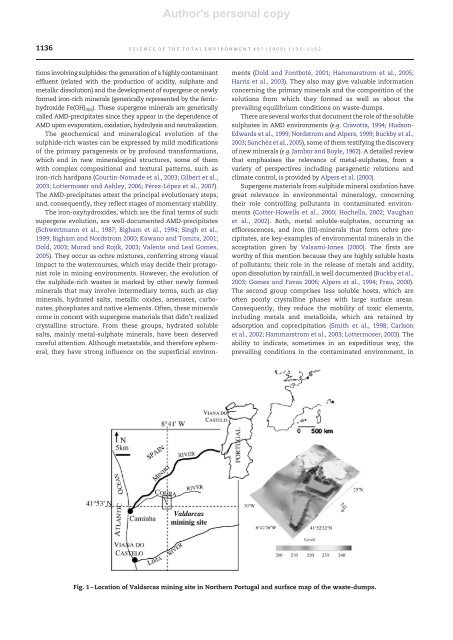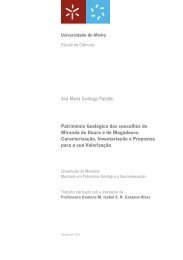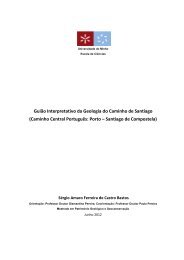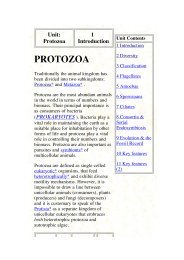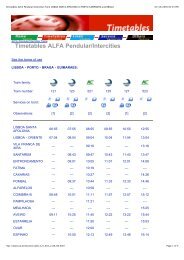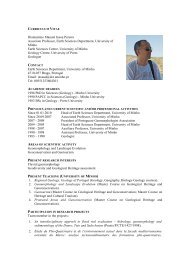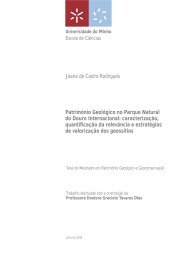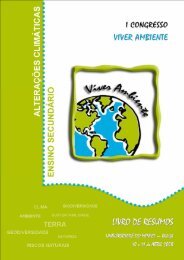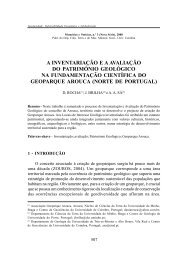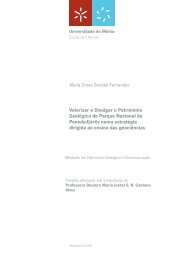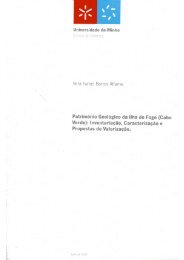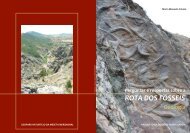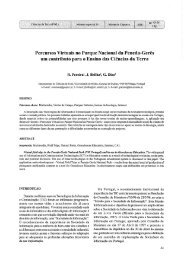Descarregue o Livro do Curso a partir daqui - Departamento de ...
Descarregue o Livro do Curso a partir daqui - Departamento de ...
Descarregue o Livro do Curso a partir daqui - Departamento de ...
Create successful ePaper yourself
Turn your PDF publications into a flip-book with our unique Google optimized e-Paper software.
Author's personal copy<br />
1136 SCIENCE OF THE TOTAL ENVIRONMENT 407 (2009) 1135– 1152<br />
tions involving sulphi<strong>de</strong>s: the generation of a highly contaminant<br />
effluent (related with the production of acidity, sulphate and<br />
metallic dissolution) and the <strong>de</strong>velopment of supergene or newly<br />
formed iron-rich minerals (generically represented by the ferrichydroxi<strong>de</strong><br />
Fe(OH) 3(s) ). These supergene minerals are generically<br />
called AMD-precipitates since they appear in the <strong>de</strong>pen<strong>de</strong>nce of<br />
AMD upon evaporation, oxidation, hydrolysis and neutralization.<br />
The geochemical and mineralogical evolution of the<br />
sulphi<strong>de</strong>-rich wastes can be expressed by mild modifications<br />
of the primary paragenesis or by profound transformations,<br />
which end in new mineralogical structures, some of them<br />
with complex compositional and textural patterns, such as<br />
iron-rich hardpans (Courtin-Noma<strong>de</strong> et al., 2003; Gilbert et al.,<br />
2003; Lottermoser and Ashley, 2006; Pérez-López et al., 2007).<br />
The AMD-precipitates attest the principal evolutionary steps,<br />
and, consequently, they reflect stages of momentary stability.<br />
The iron-oxyhydroxi<strong>de</strong>s, which are the final terms of such<br />
supergene evolution, are well-<strong>do</strong>cumented AMD-precipitates<br />
(Schwertmann et al., 1987; Bigham et al., 1994; Singh et al.,<br />
1999; Bigham and Nordstrom 2000; Kawano and Tomita, 2001;<br />
Dold, 2003; Murad and Rojík, 2003; Valente and Leal Gomes,<br />
2005). They occur as ochre mixtures, conferring strong visual<br />
impact to the watercourses, which may <strong>de</strong>ci<strong>de</strong> their protagonist<br />
role in mining environments. However, the evolution of<br />
the sulphi<strong>de</strong>-rich wastes is marked by other newly formed<br />
minerals that may involve intermediary terms, such as clay<br />
minerals, hydrated salts, metallic oxi<strong>de</strong>s, arsenates, carbonates,<br />
phosphates and native elements. Often, these minerals<br />
come in concert with supergene materials that didn't realized<br />
crystalline structure. From these groups, hydrated soluble<br />
salts, mainly metal-sulphate minerals, have been <strong>de</strong>served<br />
careful attention. Although metastable, and therefore ephemeral,<br />
they have strong influence on the superficial environments<br />
(Dold and Fontboté, 2001; Hammarstrom et al., 2005;<br />
Harris et al., 2003). They also may give valuable information<br />
concerning the primary minerals and the composition of the<br />
solutions from which they formed as well as about the<br />
prevailing equilibrium conditions on waste-dumps.<br />
There are several works that <strong>do</strong>cument the role of the soluble<br />
sulphates in AMD environments (e.g. Cravotta, 1994; Hudson-<br />
Edwards et al., 1999; Nordstrom and Alpers, 1999; Buckby et al.,<br />
2003; Sanchéz et al., 2005), some of them testifying the discovery<br />
of new minerals (e.g. Jambor and Boyle, 1962). A <strong>de</strong>tailed review<br />
that emphasises the relevance of metal-sulphates, from a<br />
variety of perspectives including paragenetic relations and<br />
climate control, is provi<strong>de</strong>d by Alpers et al. (2000).<br />
Supergene materials from sulphi<strong>de</strong> mineral oxidation have<br />
great relevance in environmental mineralogy, concerning<br />
their role controlling pollutants in contaminated environments<br />
(Cotter-Howells et al., 2000; Hochella, 2002; Vaughan<br />
et al., 2002). Both, metal soluble-sulphates, occurring as<br />
efflorescences, and iron (III)-minerals that form ochre precipitates,<br />
are key-examples of environmental minerals in the<br />
acceptation given by Valsami-Jones (2000). The firsts are<br />
worthy of this mention because they are highly soluble hosts<br />
of pollutants; their role in the release of metals and acidity,<br />
upon dissolution by rainfall, is well <strong>do</strong>cumented (Buckby et al.,<br />
2003; Gomes and Favas 2006; Alpers et al., 1994; Frau, 2000).<br />
The second group comprises less soluble hosts, which are<br />
often poorly crystalline phases with large surface areas.<br />
Consequently, they reduce the mobility of toxic elements,<br />
including metals and metalloids, which are retained by<br />
adsorption and coprecipitation (Smith et al., 1998; Carlson<br />
et al., 2002; Hammarstrom et al., 2003; Lottermoser, 2003). The<br />
ability to indicate, sometimes in an expeditious way, the<br />
prevailing conditions in the contaminated environment, in<br />
Fig. 1 – Location of Valdarcas mining site in Northern Portugal and surface map of the waste-dumps.


